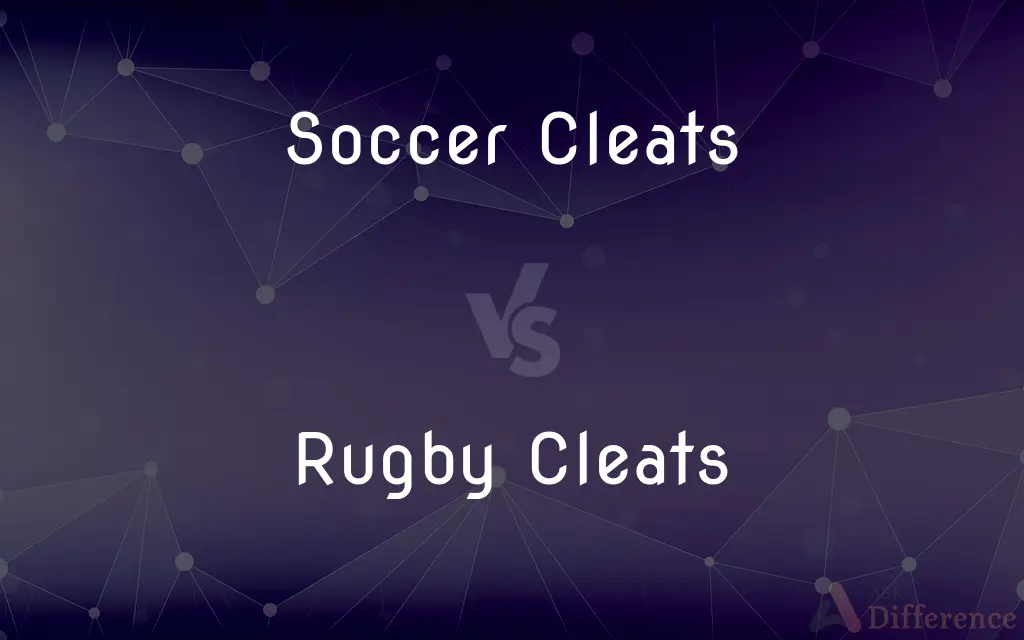Soccer Cleats vs. Rugby Cleats — What's the Difference?
By Tayyaba Rehman & Fiza Rafique — Published on February 6, 2024
Soccer cleats are lightweight, designed for agility and ball control, while rugby cleats are heavier, with more durable construction for traction in scrums.

Difference Between Soccer Cleats and Rugby Cleats
Table of Contents
ADVERTISEMENT
Key Differences
Soccer cleats are designed with a focus on speed, agility, and ball control. They typically feature a low-cut style to facilitate quick movements and have smaller, more conical studs to aid in rapid direction changes on the field. Soccer cleats prioritize a lightweight design to not encumber the player's footwork, which is crucial for dribbling, passing, and shooting the ball.
Rugby cleats, in contrast, are built for the rugged demands of rugby play. They have a more durable construction to withstand the sport's physicality, including scrums, rucks, and mauls. The studs on rugby cleats are usually longer and sometimes metal, providing better traction on natural grass surfaces, which is vital for pushing in scrums and maintaining stability during tackles.
Soccer cleats are generally made with thinner materials for a closer feel of the ball, aiding in precise touches and control. This design choice reflects the sport's emphasis on finesse and skillful ball manipulation. Soccer players require footwear that allows them to feel the ball as an extension of their foot for effective play.
Rugby cleats often have a reinforced upper and a more robust soleplate to offer greater protection to the player's feet. This is due to the direct physical contact and the nature of rugby, which involves more collisions and physical battles than soccer. Rugby players need cleats that can protect their feet and withstand the pressures of the game.
While soccer cleats are optimized for performance on well-maintained pitches and artificial surfaces, rugby cleats are designed to perform in a variety of field conditions, from soft, muddy terrains to harder, grassy surfaces. This adaptability is crucial in rugby, where field conditions can significantly impact the game's flow and the players' performance.
ADVERTISEMENT
Comparison Chart
Design Focus
Agility and ball control
Durability and traction
Stud Shape
Smaller, conical for agility
Longer, often metal for grip
Upper Material
Thinner for ball feel
Thicker for foot protection
Weight
Lightweight for speed
Heavier for stability
Cut Style
Low-cut for mobility
Varied, often with more support
Soleplate
Flexible for movement
Sturdier for physical play
Field Suitability
Well-maintained or artificial turf
Various, including soft and muddy
Compare with Definitions
Soccer Cleats
Footwear designed to increase a soccer player's agility.
His soccer cleats helped him dodge the defenders.
Rugby Cleats
Cleats suited for a variety of playing surfaces.
No matter the field, my rugby cleats perform exceptionally.
Soccer Cleats
Footwear engineered to be as light as possible.
These soccer cleats feel like feathers on my feet.
Rugby Cleats
Shoes made to offer extra protection to players' feet.
The reinforced design of these rugby cleats shields my feet from impacts.
Soccer Cleats
Cleats made to assist players in accelerating quickly.
He outran everyone thanks to his soccer cleats.
Rugby Cleats
Footwear designed to enhance player stability during play.
The sturdy build of these rugby cleats keeps me grounded.
Soccer Cleats
Shoes that enhance a player's precision with the ball.
His soccer cleats made his passes more accurate.
Rugby Cleats
Footwear built to withstand the rigors of rugby.
These rugby cleats can survive the toughest matches.
Soccer Cleats
Shoes crafted to improve ball handling skills.
The new soccer cleats improved her dribbling.
Rugby Cleats
Shoes designed to offer superior grip on the field.
His rugby cleats kept him stable in the scrum.
Common Curiosities
What are soccer cleats?
Footwear designed for agility and precision in soccer.
Are there specific cleat patterns for different positions in rugby?
Some rugby players may prefer specific cleat patterns based on their position and playing style, but there are no strict rules regarding cleat patterns in rugby.
Why are rugby cleats heavier?
To provide stability and protection in the physical game of rugby.
How do you maintain Soccer Cleats?
To prolong their lifespan, soccer cleats should be cleaned after each use, kept dry, and stored in a cool, well-ventilated area.
How do rugby cleats differ from soccer cleats?
They are built for traction and durability in rugby's physical play.
Are Soccer Cleats suitable for casual wear?
Soccer cleats are primarily designed for playing soccer and may not be as comfortable for everyday use due to their specialized design.
Do Soccer Cleats come in different styles?
Yes, soccer cleats come in various styles, including firm ground (FG), soft ground (SG), turf (TF), and indoor (IN), each designed for specific playing surfaces.
Can soccer cleats be used for rugby?
Not recommended due to lack of protection and traction for rugby.
Can you use Soccer Cleats on artificial turf?
Yes, there are turf (TF) soccer cleats designed for use on artificial turf surfaces, providing the necessary traction without damaging the turf.
How do you maintain Rugby Cleats?
To prolong their lifespan, rugby cleats should be cleaned after each use, kept dry, and stored in a cool, well-ventilated area.
Can you use Rugby Cleats on artificial turf?
Rugby cleats are generally designed for natural grass fields and may not be suitable for artificial turf. Specialized turf shoes or boots may be required for synthetic surfaces.
Are Rugby Cleats suitable for casual wear?
Rugby cleats are primarily designed for playing rugby and may not be as comfortable or suitable for everyday casual wear due to their specialized design.
Are Soccer Cleats available in different sizes?
Yes, soccer cleats come in various sizes to accommodate different foot sizes and shapes.
Can Soccer Cleats be used for other sports?
While primarily designed for soccer, some people use soccer cleats for sports like ultimate frisbee or lacrosse due to their traction and grip.
Share Your Discovery

Previous Comparison
Peanut Butter vs. Jelly
Next Comparison
Single Phase Motor vs. Three Phase MotorAuthor Spotlight
Written by
Tayyaba RehmanTayyaba Rehman is a distinguished writer, currently serving as a primary contributor to askdifference.com. As a researcher in semantics and etymology, Tayyaba's passion for the complexity of languages and their distinctions has found a perfect home on the platform. Tayyaba delves into the intricacies of language, distinguishing between commonly confused words and phrases, thereby providing clarity for readers worldwide.
Co-written by
Fiza RafiqueFiza Rafique is a skilled content writer at AskDifference.com, where she meticulously refines and enhances written pieces. Drawing from her vast editorial expertise, Fiza ensures clarity, accuracy, and precision in every article. Passionate about language, she continually seeks to elevate the quality of content for readers worldwide.













































